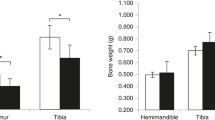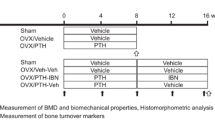Summary
The Walker 256/B mammary carcino-sarcoma implanted in male Fischer rats was used to evaluate bone resorption inhibitors. The model was improved by thyroparathyroidectomizing the animals to avoid counter-regulation by parathyroid hormone or calcitonin, by pair-feeding them, and by using 2 hour fasting calciuria as a resorption index to minimize the influence of differences in growth or in intestinal calcium absorption. Over a 10 day period, the control animals displayed a progressive increase of plasma calcium (Ca) and fasting urinary Ca excretion, a decrease of plasma phosphate, and an increase of urinary phosphate excretion. Osteocalcin did not change. The daily administration of dichloromethylene bisphosphonate (Cl2MBP) totally prevented the increase of fasting urinary Ca excretion, whereas plasma Ca remained at a higher level than thyroparathyroidectomized (TPTX) control rats. Osteocalcin decreased. Two new aminobisphosphonates, 4-amino-1-hydroxybutylidene-1,1-bisphosphonate (AHBuBP), and 6-amino-1-hydroxyhexylidene-1,1-bisphosphonate (AHHexBP) had a similar effect. The order of potency shown by the three bisphosphonates was similar to that reported using the metaphyseal bone density evaluation method in growing rats: AHBuBP>AHHexBP>Cl2MBP, the difference each time being one order of magnitude. The analysis of the relationship between urinary and plasma values in tumor-bearing animals suggested an increased renal tubular reabsorption of Ca and a decreased reabsorption of phosphate (Pi). Therefore, in this model of malignant osteolysis, urinary Ca excretion is the best marker for bone resorption.
Similar content being viewed by others
References
Mundy GR, Martin TJ (1982) The hypercalcemia of malignancy: pathogenesis and management. Metabolism 31: 1247–1277
Mundy GR, Ibbotson KJ, D'Souza SM, Simpson EL, Jacobs JW, Martin TJ (1984) The hypercalcemia of cancer. Clinical implications and pathogenic mechanisms. N Engl J Med 310:1718–1727
Martodam RR, Thornton KS, Sica D, D'Souza SM, Flora L, Mundy GR (1983) The effects of dichloromethylene diphosphonate on hypercalcemia and other parameters of the humoral hypercalcemia of malignancy in the rat Leydig cell tumor. Calcif Tissue Int 35:512–519
Johnson KY, Wesseler MA, Olson HM, Martodam RR, Poser JW (1982) The effects of diphosphonates on tumor-induced hypercalcemia and osteolysis in Walker carcinosarcoma 256 (W-256) of rats. In: Donath A, Courvoisier B (eds) Diphosphonates and bone. Symposium CEMO IV, Nyon, Switzerland, Eds Médecine et Hygiène, Genève, pp 386–389
Jung A, Bornand J, Mermillod B, Edouard C, Meunier PJ (1984) Inhibition by bisphosphonates of bone resorption induced by the Walker tumor of the rat. Cancer Res 44:3007–3011
Guaitani A, Polentarutti N, Filippeschi S, Marmonti L, Corti F, Italia C, Coccioli MG, Mantovani A, Garattini S (1984) Effects of disodium etidronate in murine tumor models. Eur J Clin Oncol 20:685–693
Ralston SH, Fogelman I, Gardner MD, Dryburgh FJ, Cowan RA, Boyle IT (1984) Hypercalcemia of malignancy: evidence for a non-parathyroid humoral agent with an effect on renal tubular handling of calcium. Clin Sci 66:187–191
Rizzoli R, Caverzasio J, Fleisch H, Bonjour JP (1986) Parathyroid hormone-like changes of renal calcium and phosphate reabsorption induced by Leydig cell tumor in thyroparathyroidectomized rats. Endocrinology 119:1004–1009
Nordin BEC, Horsman A, Aaron J (1976) Diagnostic procedures. In: Nordin BEC (ed) Calcium, phosphate and magnesium metabolism. Churchill Livingstone, Edinburgh, London, New York, pp 471–472
Minne H, Raue F, Bellwinkel S, Ziegler R (1975) The hypercalcemic syndrome in rats bearing the Walker carcinosarcoma 256. Acta Endocrinol 76:613–624
Schmid-Gayk H, Löhrke H, Fischkal A, Goerttler K, Hofmann F (1979) Urinary cyclic AMP and bone histology in Walker carcinosarcoma: evidence of parathyroid hormone-like activity. Eur J Cancer 15:1211–1218
Fleisch H (1983) Bisphosphonates: mechanisms of action and clinical applications. In: Peck WA (ed) Bone and Mineral Research, annual 1. Excerpta Medica, Amsterdam, Oxford, Princeton pp 319–357
Schenk R, Eggli P, Felix R, Fleisch H, Rosini S (1986) Quantitative morphometric evaluation of the inhibitory activity of new aminobisphosphonates on bone resorption in the rat. Calcif Tissue Int 38:342–349
Chen PS, Toribara TY, Warner H (1956) Microdetermination of phosphorus. Anal Chem 28:1756–1758
Nishimoto SK, Price PA (1980) Secretion of the vitamin K-dependent protein of bone by rat osteosarcoma cells. Evidence for an intracellular precursor. J Biol Chem 255:6579–6583
Brown BL, Albano JDM, Ekins RP, Sgherzi AM (1971) A simple and sensitive saturation assay method for the measurement of adenosine 3′,5′-cyclic monophosphate. Biochem J 121:561–562
Seyberth HW, Bonsch G, Müller H, Minne HW, Erlenmaier T, Strein K, Imbeck H, Mrongovius R (1980) Prostaglandin E production and hypercalcemia in rats bearing the Walker carcinosarcoma. Br J Cancer 42:455–461
Brown JP, Delmas PD, Malaval L, Edouard C, Chapuy MC, Meunier PJ (1984) Serum bone Gla protein: a specific marker for bone formation in postmenopausal osteoporosis. Lancet i:1091–1093
Tam CS, Heersche JNM, Santora A, Spiegel AM (1984) Skeletal response in rats following the implantation of hypercalcemia-producing Leydig cell tumors. Metabolism 33:50–53
Insogna KL, Stewart AF, Vignery AMC, Weir EC, Namnum PA, Baron RE, Kirkwood JM, Deftos LM, Broadus AE (1984) Biochemical and histomorphometric characterization of a rat model for humoral hypercalcemia of malignancy. Endocrinology 114:888–896
Stronski S, Trechsel U, Fleisch H (1986) Plasma osteocalcin: lack of relation with bone resorption and effect of bisphosphonates in rats. Calcif Tissue Int 38:539
Author information
Authors and Affiliations
Rights and permissions
About this article
Cite this article
Rizzoli, R., Fleisch, H. The Walker 256/B carcinosarcoma in thyroparathyroidectomized rats: A model to evaluate inhibitors of bone resorption. Calcif Tissue Int 41, 202–207 (1987). https://doi.org/10.1007/BF02555239
Received:
Revised:
Issue Date:
DOI: https://doi.org/10.1007/BF02555239




